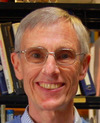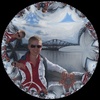EPaDel Fall 2017 Section Meeting
The fall 2017 meeting of the EPaDel section of the MAA was held November 18, 2017 at Shippensburg University.
Invited Speakers
 Frank Morgan (Williams College)
Frank Morgan (Williams College)
The Most Efficient Tile of Space- The unit cube minimizes surface area among all unit-volume polyhedra of six faces to tile space. With more faces you can do better; with fewer faces you do worse. Only two other cases are known, one proved this past summer by undergraduates.
- Frank Morgan of Williams College works in geometry and serves as Editor-in-Chief of Notices of the American Mathematical Society, the largest publication in higher mathematics. He has over 200 publications, including six books, ranging from the MAA's Math Chat Book to a graduate text in geometric measure theory. He served as MAA vice-president and was an inaugural winner of the MAA Haimo teaching award.
 Jackie Jensen-Vallin (Editor, MAA Focus)
Jackie Jensen-Vallin (Editor, MAA Focus)
Let's Get Knotty!- My early interest in numbers and patterns lead me down a (nonlinear) path to mathematics, which has led me to the twisty world of knots. Mathematically, knots are non-intersecting closed curves in space. We will use sequences and patterns to explore this world and play with a classic question in knot theory - given a knot diagram, how do I identify the knot? There will be plenty of examples, conjectures, and fun!
- Jacqueline Jensen-Vallin is Editor of MAA FOCUS. She earned her Ph.D. from University of Oregon in 2002, and then taught at Sam Houston State University and Slippery Rock University before settling at Lamar University, where she is now the Director of the First-Year Math Experience. She is a member of the MAA Congress and winner of the MAA’s Alder Award for Outstanding Teaching by a beginning faculty member in 2008. She is also co-editor of Springer's Women in Mathematics: Celebrating the Centennial of the Mathematical Association of America, due out in January 2018.
 Evelyn Lamb (freelance writer)
Evelyn Lamb (freelance writer)
Visualizing Hyperbolic Geometry- For two thousand years, mathematicians tried to prove that Euclidean geometry, the geometry you probably learned in high school, was all there was. But it's not! In the early nineteenth century, János Bolyai and Nikolai Lobachevsky independently discovered that by tweaking one of Euclid's postulates, geometry can look totally different. We will explore the rich world of hyperbolic geometry, one of the new and beautiful systems of geometry that results from this tweak. Our guides on the adventure will be mathematically inspired artists and artistically inspired mathematicians, including M.C. Escher, Daina Taimina, and Henry Segerman.
- Dr. Evelyn Lamb is a freelance math and science writer based in Salt Lake City. She earned her Ph.D. in mathematics at Rice University in 2012 and taught at the University of Utah until 2015. She began her science writing career in 2012 with a AAAS-AMS mass media fellowship at Scientific American. It was love at first blog post, and she has been making mathematical concepts fun and accessible to a general audience ever since. In addition to math, she loves music, sewing, and the outdoors. Dr. Lamb has written for outlets including Scientific American, Slate, Nautilus, and the American Mathematical Society. Her blog Roots of Unity is hosted on the Scientific American blog network, and she coauthors the Blog on Math Blogs for the AMS. Follow her on Twitter: @evelynjlamb.
Workshops
Faculty Contributed Paper Session
Faculty talk schedule (PDF)
Faculty talk abstracts (PDF)
Student Contributed Paper Session
Student talk schedule (PDF)
Student talk abstracts (PDF)
Student Activity
All Tangled Up: An Exploration In Knot Theory
Forget the fidget spinners! In this activity session, we'll be playing with the original fidget toy; Tangles! A Tangle is a collection of quarter-circle shaped plastic pieces that snap together. These toys are mathematical tools useful for studying knots. Through a sequence of questions, we will explore planar Tangles in search of patterns and properties. After playing with the Tangles and making conjectures, there will be time to discuss these conjectures.
Here are the solutions to the student activity.
Lunch Table Discussions
Lunch Discussion Topics (PDF)
Schedule
The conference takes place in the Dauphin Humanities Center.
| Time | Event |
|---|---|
| 8:30 - 10:30 | Registration DHC Lobby |
| 8:30 - 3:45 | Silent Auction DHC Lobby |
| 8:30 - 9:05 | Light Breakfast Reception DHC Lobby |
| 9:05 - 9:15 | Welcoming Remarks DHC 051 |
| 9:15 - 10:10 | Jackie Jensen-Vallin (Editor, MAA Focus) Let's Get Knotty! DHC 051 |
| 10:10 - 10:30 | Coffee Break DHC Lobby |
| 10:30 - 11:30 | Frank Morgan (Williams College) The Most Efficient Tile of Space DHC 051 |
| 11:30 - 12:50 | Lunch & Table Discussions Reisner Dining Hall |
| 12:50 - 1:45 Concurrent sessions |
Workshop by Frank Morgan (Williams College) The Most Efficient Tile of Space DHC 051 | Faculty Contributed Paper Sessions Various Locations |
| Student Activity DHC 151 | |
| 1:45 - 2:35 | Student Contributed Paper Sessions Various Locations |
| 2:35 - 3:30 | Evelyn Lamb (freelance writer) Visualizing Hyperbolic Geometry DHC 051 |
| 3:30 - 3:35 | Section Officers Election Section Awards Presentation Business Meeting DHC 051 |
| 3:35 - 3:45 | Group Photo Outside DHC Lobby |
| 3:45 - 4:15 | Reception & Silent Auction Winner Announcement DHC Lobby |